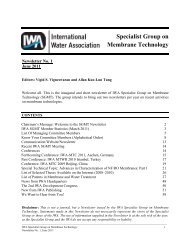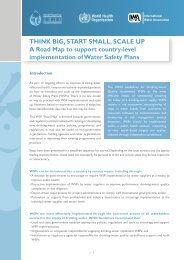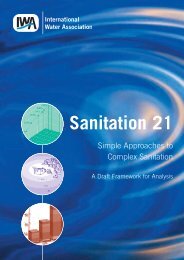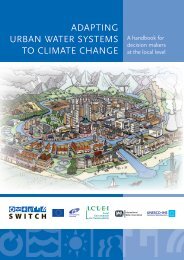Specialist Group on Use of Macrophytes in Water Pollution ... - IWA
Specialist Group on Use of Macrophytes in Water Pollution ... - IWA
Specialist Group on Use of Macrophytes in Water Pollution ... - IWA
Create successful ePaper yourself
Turn your PDF publications into a flip-book with our unique Google optimized e-Paper software.
C<strong>on</strong>centrati<strong>on</strong> (mg/l)<br />
160<br />
140<br />
120<br />
100<br />
80<br />
60<br />
40<br />
20<br />
0<br />
COD Amm<strong>on</strong>ia-N MRP<br />
Variables<br />
Influent I-Tap I<br />
I-Tap II I-Tap III<br />
II-Tap I II-Tap II<br />
II-Tap III<br />
Figure 5. <strong>Water</strong> quality variables for domestic wastewater mesocosms (I: mesocosm 3; II:<br />
mesocosm 4; Tap I: surface flow water; Tap II: oxidized sediment layer; Tap III: reduced<br />
sediment layer; COD: chemical oxygen demand; Amm<strong>on</strong>ia-N: amm<strong>on</strong>ia-nitrogen; MRP:<br />
molybdate reactive phosphorus).<br />
Plant<br />
C<strong>on</strong>cern<strong>in</strong>g the two mesocosms treat<strong>in</strong>g domestic wastewater, mesocosm 3 had higher<br />
reducti<strong>on</strong> removal efficiencies <strong>of</strong> COD, amm<strong>on</strong>ia-nitrogen, MRP and SS to those <strong>of</strong><br />
mesocosm 4. It suggests that the presence <strong>of</strong> Agrostis stol<strong>on</strong>ifera <strong>in</strong> planted mesocosms has<br />
limited the diffusi<strong>on</strong> <strong>of</strong> oxygen (as electr<strong>on</strong> recepti<strong>on</strong>) to the lower sediment layers.<br />
Relatively low oxygen c<strong>on</strong>centrati<strong>on</strong>s can be identified as the ma<strong>in</strong> c<strong>on</strong>tributor to the<br />
<strong>in</strong>adequate removal <strong>of</strong> COD and amm<strong>on</strong>ia-nitrogen.<br />
Groundwater c<strong>on</strong>tam<strong>in</strong>ati<strong>on</strong><br />
An outlet valve was located <strong>on</strong> the base plate <strong>of</strong> each experimental mesocosm <strong>in</strong> to gauge the<br />
possibility <strong>of</strong> groundwater c<strong>on</strong>tam<strong>in</strong>ati<strong>on</strong> by <strong>in</strong>filtrati<strong>on</strong> <strong>of</strong> the polluted water. However, no<br />
leachate was collected throughout the study period. The absence <strong>of</strong> measurable <strong>in</strong>filtrati<strong>on</strong><br />
can be expla<strong>in</strong>ed by the presence <strong>of</strong> a compact bent<strong>on</strong>ite clay layer, act<strong>in</strong>g as an excellent<br />
barrier to prevent nutrient transfer to potential aquifers. Furthermore, some <strong>of</strong><br />
biogeochemical processes play important roles <strong>in</strong> clogg<strong>in</strong>g <strong>of</strong> the soil matrix. For example,<br />
biomass accumulati<strong>on</strong> and/or <strong>in</strong>soluble biogas (i.e. methane) formati<strong>on</strong> through soil microbes<br />
(Kellner et al. 2004; Tokida et al. 2005).<br />
Sediment management<br />
In March 2005, sediment accumulati<strong>on</strong>s were measured at six ICW sites <strong>in</strong> <strong>Water</strong>ford. The<br />
mean accumulati<strong>on</strong> rates were approximately 3 cm per annum for moderately loaded<br />
systems. Previous research (Scholz 2007) <strong>in</strong>dicated that the approximate sludge removal<br />
frequency <strong>of</strong> cell 1 with<strong>in</strong> ICW site 11 would be n<strong>in</strong>e years c<strong>on</strong>sider<strong>in</strong>g p<strong>on</strong>d capacity.<br />
However, from the nutrient removal perspective, ICW cells require desludg<strong>in</strong>g every 5 to 6<br />
years. For some heavily loaded systems, more frequent desludg<strong>in</strong>g appears to be necessary.<br />
____________________________________________________________________________________________________<br />
<strong>IWA</strong> <str<strong>on</strong>g>Specialist</str<strong>on</strong>g> <str<strong>on</strong>g>Group</str<strong>on</strong>g> <strong>on</strong> <strong>Use</strong> <strong>of</strong> <strong>Macrophytes</strong> <strong>in</strong> <strong>Water</strong> Polluti<strong>on</strong> C<strong>on</strong>trol: Newsletter No. 38 21

















